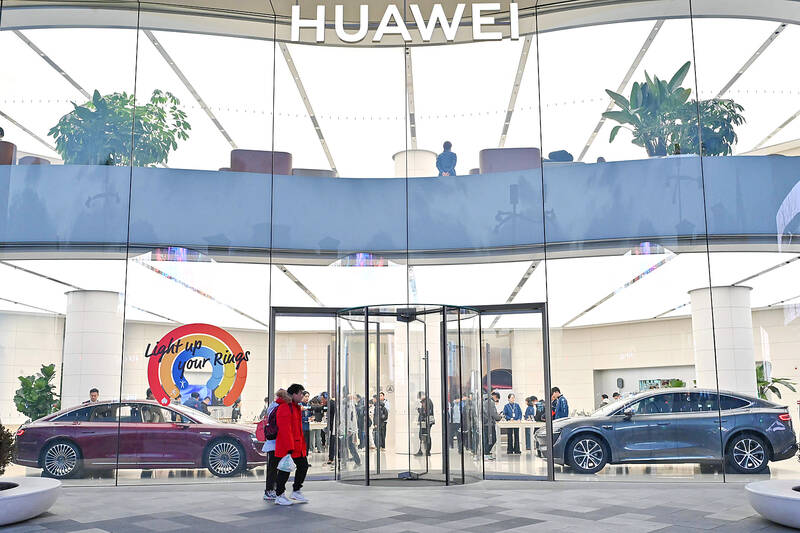Huawei Technologies Co (華為) will from next year strip its smartphones and tablets of Google’s open-source Android and move devices to homegrown software, broadcasting its ambitions to pivot away from US technology.
The company’s new flagship phone, the Mate 70, will debut HarmonyOS Next, the iteration of its operating system that does away with remnants of Android in favor of entirely indigenous tech. Announced at a live-streamed event yesterday, the new devices fuel Huawei’s campaign to reclaim China’s premium tier from Apple Inc and build an ecosystem without the involvement of major US tech providers.
Available on Wednesday next week, the Mate 70 and its Pro variants are the followup to Huawei’s most significant device in years, the Mate 60.

Photo: Adek Berry, AFP
Last year’s edition, powered by a made-in-China processor, brought Huawei back into the smartphone industry limelight and signaled its ability to work around US trade curbs designed to cut it off from the most advanced chipmaking.
HarmonyOS Next will still need another two to three months to improve the user experience, but the plan is to henceforth use it on upcoming gadgets, said Richard Yu (余承東), chairman of Huawei’s consumer business group.
The Mate 70 series will offer 40 percent better performance than its predecessor, in part because of HarmonyOS Next, Yu said, falling short of disclosing details of the processors that power the phones.
Shenzhen-based Huawei is expected to use its latest in-house Kirin chip for the new product line, though its performance increase may be less significant than Qualcomm Inc and MediaTek Inc’s (聯發科) top-end offerings, according to Bloomberg Intelligence analysts Charles Shum (沈明) and Sean Chen.
“That suggests the new Huawei phone may struggle to capture the attention of non-Huawei Android users,” they wrote.
Despite Washington’s blacklisting and technical challenges, Huawei managed to grow sales over the past seven quarters, with the help of an expanding smartphone business. Its shipments recorded four consecutive quarters of at least double-digit growth in China as of September, according to research firm International Data Corp.
Huawei yesterday also unveiled a number of other products including a new tablet and a gold-plated smartwatch. Earlier in the fall, the company introduced the world’s first trifold phone, also powered by chips that were designed in-house.

Intel Corp chief executive officer Lip-Bu Tan (陳立武) is expected to meet with Taiwanese suppliers next month in conjunction with the opening of the Computex Taipei trade show, supply chain sources said on Monday. The visit, the first for Tan to Taiwan since assuming his new post last month, would be aimed at enhancing Intel’s ties with suppliers in Taiwan as he attempts to help turn around the struggling US chipmaker, the sources said. Tan is to hold a banquet to celebrate Intel’s 40-year presence in Taiwan before Computex opens on May 20 and invite dozens of Taiwanese suppliers to exchange views

Application-specific integrated circuit designer Faraday Technology Corp (智原) yesterday said that although revenue this quarter would decline 30 percent from last quarter, it retained its full-year forecast of revenue growth of 100 percent. The company attributed the quarterly drop to a slowdown in customers’ production of chips using Faraday’s advanced packaging technology. The company is still confident about its revenue growth this year, given its strong “design-win” — or the projects it won to help customers design their chips, Faraday president Steve Wang (王國雍) told an online earnings conference. “The design-win this year is better than we expected. We believe we will win

Chizuko Kimura has become the first female sushi chef in the world to win a Michelin star, fulfilling a promise she made to her dying husband to continue his legacy. The 54-year-old Japanese chef regained the Michelin star her late husband, Shunei Kimura, won three years ago for their Sushi Shunei restaurant in Paris. For Shunei Kimura, the star was a dream come true. However, the joy was short-lived. He died from cancer just three months later in June 2022. He was 65. The following year, the restaurant in the heart of Montmartre lost its star rating. Chizuko Kimura insisted that the new star is still down

While China’s leaders use their economic and political might to fight US President Donald Trump’s trade war “to the end,” its army of social media soldiers are embarking on a more humorous campaign online. Trump’s tariff blitz has seen Washington and Beijing impose eye-watering duties on imports from the other, fanning a standoff between the economic superpowers that has sparked global recession fears and sent markets into a tailspin. Trump says his policy is a response to years of being “ripped off” by other countries and aims to bring manufacturing to the US, forcing companies to employ US workers. However, China’s online warriors